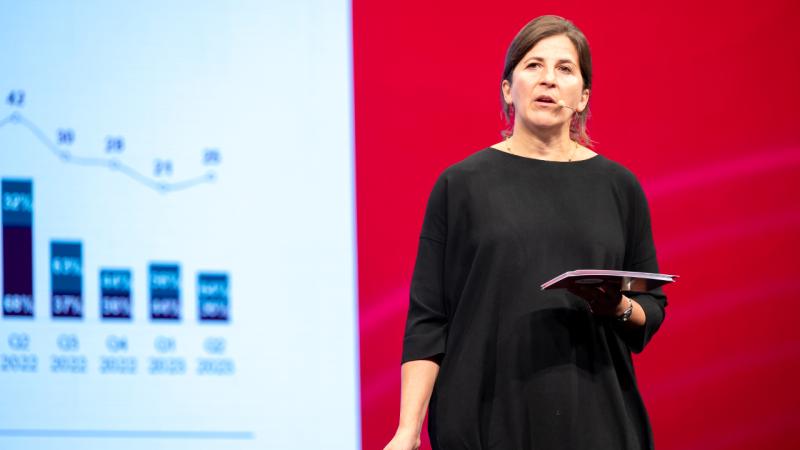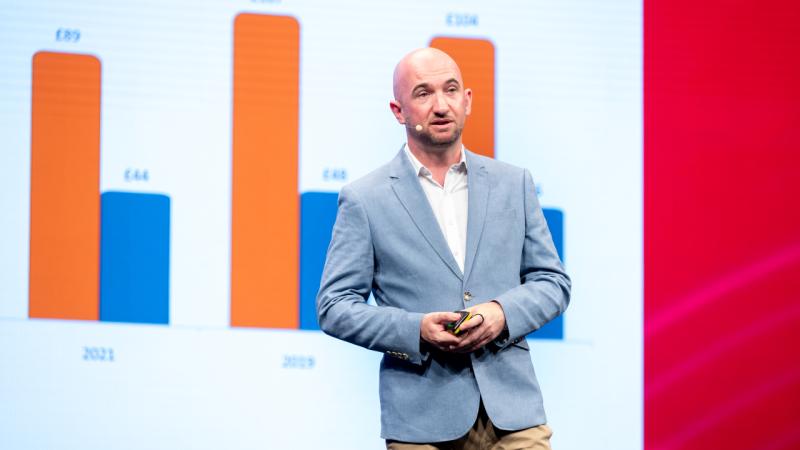In an ever-changing industry landscape characterized by fluctuating market dynamics, rising interest rates and emerging sustainability concerns, understanding the intricate shifts in the hotel sector remains crucial. Speaking at this year’s Annual Hotel Conference, three industry experts explored financial factors influencing hotel investments, UK hotel performance, operational trends, as well as the challenges and opportunities facing hoteliers moving forward.
Reasons to be positive

Thomas Emanuel, senior director at STR, a division of CoStar Group notes that while there has been a significant boost to average room rates post-pandemic, rates across the country are still lagging behind the consumer price index except in London where average rates are tracking above CPI when indexed on the period post the 2008 global financial crisis.
Year-to-date occupancy in the UK matches 2019 levels at 77 per cent, faring better than other European markets; 10 per cent ahead of France and Germany as well as more than 7 per cent ahead of Spain, Italy and the Netherlands.
He adds: “Demand is up 0.6 per cent, so we're actually selling more rooms in 2023 than we were before the pandemic.”
However, despite the high-level, positive overview, there are still areas which need improvement. Group occupancy is still 45 per cent behind 2019 levels and China - a massive market for the UK's tourism industry - is also yet to return to 2019 figures.
Looking ahead, however, he remains positive on the above. “Group occupancy is recovering and versus last year, we’re getting some of that group demand back. Inbound Chinese visitors represented 5 per cent of overnights in 2019. We'll get back to that level in 2025,” he says.
Turning to challenges, he notes food & beverage (F&B) revenues have slowed year-on-year while costs have continued to increase, therefore impacting Gross Operating Profit Per Available Room (GOPPAR) and the bottom line.
“GOPPAR is in negative territory in June and July and we've seen significant cost growth, particularly in utilities, labour, rooms and admin in general. So there are some challenges on the bottom line.”
Emanuel also draws attention to the significant occupancy influence wielded by the allocation of between 30,000 to 35,000 rooms to refugees through Home Office contracts, stating this is in inflating occupancy on a nationwide level by about 2 to 3 per cent, warning that a close eye needs to be kept on this as many of these contracts will soon run out.
An intriguing trend reversal post-pandemic is evident in the occupancy growth and rate patterns across hotel classes when comparing year-on-year. While luxury hotels once dominated rate hikes – and rates have indeed continued to surge at the top end of the market -, when comparing 2022 performance with 2023, it's now the economy and mid-scale segments leading the way and pushing rates at a stronger pace than the luxury segment.
Post pandemic, there has been a surge in staycations over the past couple of years, and the industry has witnessed the rise of 'work from home' and 'bleisure' travel. As Emanuel elaborates, these changes have significantly impacted occupancy patterns, with the dominance of Monday work-from-home culture depressing Monday night hotel bookings, but the increasing integration of leisure with business trips balancing out the equation towards the week's end.
Turning to the hotel construction landscape, he notes that while factors such as restrictions and supply chain issues during the pandemic had a negative impact, those have slowed. 44per cent of all under construction rooms and 25per cent of all active pipeline rooms are in the capital and London remains the city with the biggest pipeline in Europe.
Moving on to recent trends over the last six weeks, Emanuel points out there has been a narrowing of growth in average rates, tacking this narrowing down to a normalisation.
“We're not going to be able to keep up with these double-digit rate increases so we expect to see low to middle single digit rate increases moving forward. That pattern is even more apparent in London where we've seen really, really marginal growth in the last six weeks or so, year-on-year when looking at rates.”
Looking ahead, Emanuel is optimistic. Corporate travel and demand are on the upswing. However, challenges loom, including the potential end of using rooms for refugees and economic pressures impacting disposable incomes and therefore domestic demand.
As a result, Emanuel forecasts “a very slight occupancy decline across regional UK in 2024. But rates will be up, so overall revpar will be just about positive before it returns to 2 per cent growth in 2025.”
Price disparity in the deals market

Carine Bonnejean, managing director of hotels at Christie & Co notes that positively, revpar is up by 13.6 per cent year-on-year, its highest level in decades. However, the Bank of England base rate is up by 300 basis points to 5.25 per cent - marking its highest levels since the 2008 financial crash – with this hike having a significant negative impact on deal activity and the level of UK hotel transactions.
“Historically, the UK has been the backbone of the European hotel transaction market. However, in 2022 European hotel transactions went down by 10 per cent, mostly due to the slowdown in activity in the UK. Unfortunately, this trend has actually continued into 2023, and the disconnect between top line asset pricing and financing challenges have continued to impact deal flow,” she stated.
The vast majority of transactions in the UK have been individual deals due to challenges around the financing of portfolios. However, she notes there’s a high amount of capital interested in investing in hotels as they have proven to be a very good hedge against inflation and forecasts an increase in activity over the next six to 12 months. The barrier to more transactions seems to be the price disparity – with sellers demanding higher prices due to robust performance, and buyers having to account for increasing debt costs.
While transactions have been muted, Bonnejean sees an interesting trend in where hotels have transacted so far post-pandemic.
“When we started seeing the return of leisure deals, we saw coastal areas, rural locations and leisure assets finally being of interest to investors. There’s a good return to Northern Ireland and Scotland, a few key transactions in Edinburgh and London and also in rural locations.”
Turning to who the active buyers are, Bonnejean notes a return of cross-border capital in 2023 compared to 2022.
She adds: “But what's more interesting is the capital composition for this year, where institutional investors and private equity haven't been able to transact that much because they need high returns, and the leverage condition and the pricing of assets have had an impact. We've seen a shift towards listed companies and REITs such as Pandox and Dalata as well as corporate hoteliers being very active. Buyers that are not relying on debt have also been able to transact more.”
For those relying on debt to fund transactions Aareal, Leumi UK, OakNorth Bank, Ares, KSL Capital Partners, RBS, M&G Real Estate and HSBC are just some of those that have been able to support on debt and refinancing in the last few months.
While refinancing remains a concern, Bonnejean notes there is now a wider, diverse network of lenders happy to support hospitality transactions.
“Based on data from our debt advisory team, the lending mix is now about 75 per cent alternative challengers versus 25 per cent high street when in the past that mix was about 60 per cent high street and 40 per cent alternative and challengers.
They will fund you deals but it’s going to cost you a lot more, about 0.5 to 2 per cent higher on the margin. But on the other side, they are likely to give you a higher loan amount than the traditional banks,” she adds.
Turning to distress, Bonnejean notes there has been no significant distress in the sector, primarily due to a V-shaped recovery and unwavering bank support. However, the next 12 to 18 months may be a bit different as much of the debt with an expiry date in 2022 has been moved to 2023 and 2024, with some lender-owner relationships deteriorating since.
She notes that the government's use of hotel rooms for asylum seekers has also provided a lifeline to at least 400 hotels, allowing a lot of hotels that would have had a hard time post-Covid, to keep their properties and delay a sale.
“We haven’t seen any distress yet. But when you look at previous crises, it took about 24 to 36 months for distress to really appear in the market. The refinancing wave on the horizon is probably going to create opportunities.” she notes.
Turning to yields, she notes that UK hotel yields have been very late to adapt to crippling inflation and rising interest rates compared to other commercial sectors such as offices and retail, but the dial has started to move and there’s more yield softening in the coming months.
Addressing ESG, Bonnejean says green premiums have started to make an appearance, adding that while it’s still too early to talk about brown discounts, its coming and people need to anticipate that or see the value of their assets reduced.
So what's in store for the future? Bonnejean notes that pipeline activity in the UK market has picked up and forecasts an improvement in deal activity towards the back end of 2023 and the first half of 2024, highlighting the Village Hotels portfolio and Center Parcs being put on the market.
To conclude, she says “Capital is just waiting for more opportunities to arrive at a price that can support their return. But they need this bid ask spread to start adjusting and we’ve started to see that. Financing will remain a massive stumbling block; cheap debt is gone and is not coming back and you need to reflect it in your pricing and return expectations.”
F&B and energy inflation easing

Michael Grove, chief operating officer at Hotstats says that although there has been a notable increase in revenue exceeding 2019 levels, that hasn’t necessarily translated into profitability due to an increase in costs across the board, with cities like Liverpool, Cardiff, Bristol, Manchester, Glasgow, Nottingham and Dublin achieving lower profitability despite seeing “quite significant revenue growth from a total revenue perspective.”
From booking to room expenses, costs have skyrocketed.
“We’ve seen a significant growth in costs over the last few years and costs are well ahead of 2019 levels. Some areas have slowed down slightly such as booking costs, up 3 per cent year-to-date compared to 2022 but rooms expenses per occupied room are 16 per cent up,” Grove notes.
We saw a massive increase in 2022 to F&B cost of sales due to supply chain issues but we’re seeing a bit of a slowdown in that area, with the percentage increase from 2022 to 2023 at 3 per cent. Sales and marketing costs have gone up 27 per cent year-to-date 2023 versus 2022, energy/utilities costs are 37 per cent higher than last year, and property & maintenance costs are up 12 per cent.”
While energy costs remain an issue, Grove says it appears the rollercoaster seems to be heading downhill, albeit not before a difficult winter.
“Energy costs have been one of our biggest challenges over the last year bit it appears we’re on our way back down. Many operators I speak to are saying maybe now isn’t the best time to lock into a long-term deal. We're at the lowest consumption point of the year as we stand and unless we see a real tail off from a pricing point of view, the winter will be another challenge for us.”
But it seems energy costs aren’t the biggest concern for Grove, with that spot going to F&B costs as he notes that closer attention needs to be paid to profit margins in that area.
“Labour margin in F&B has seen a 2 percentage point increase, is a challenge to food & beverage profitability. From a food and beverage margin point of view, in 2018 it was 32per cent, in 2019 it was around 28per cent and now things have evolved to the point where we’re at 22per cent food & beverage profit. So that’s a 10 percentage point change since 2018,” he says.
“There’s a lot of focus on energy costs but if I measured both F&B and energy and the impact on margin change versus that same time in 2019, it's actually food & beverage profit that has actually impacted the bottom line more than the energy cost issue.”
It seems that amidst the chatter around spiralling energy costs, it's the F&B profit margin that has made a more profound dent in the industry's bottom line. Moving forward, Grove calls for a strategy rethink around F&B and how profitability can be optimised in that area.
“I think we’re in a situation where we’ll see standalone bars and restaurants closing around the country and having real challenges in making profit. And from a hotel perspective, it's no longer just an area of the business that operates as a profit centre. It could just be that as it is right now, we need to rethink the way that the hotel interlinks with food & beverage to maximise profitability.”
More generally, he adds that although labour rates in the sector exhibit signs of stabilization, they are still considerably higher than the previous year, casting a shadow of uncertainty for hoteliers.